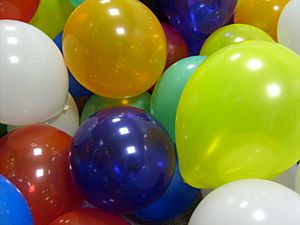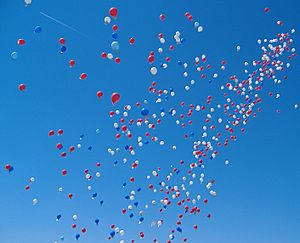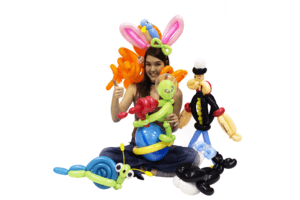Toy balloon facts for kids
A toy balloon or party balloon is a small balloon often used for decorating, advertising, or as a fun toy for kids. These balloons are usually made from rubber or shiny plastic. They are filled with air or helium to make them inflate.
Toy balloons come in many different sizes and shapes. Most are round or oval, about 10 to 30 centimeters wide. It's important to know that "sky lanterns" (paper balloons that float using hot air) are not considered toy balloons, even though they were once used as toys.
It's very important to be safe with balloons. Some children have had serious accidents with latex balloons, especially if they break or are breathed in. Experts suggest that parents choose Mylar balloons instead of latex ones for younger children, as they are often safer.
Contents
Shiny Foil Balloons
Foil balloons are made from special plastics, like a strong film called biaxially-oriented PET film. Unlike rubber balloons, foil balloons don't stretch much. This means that cool pictures and designs printed on them stay clear and don't get stretched out when the balloon is blown up.
These balloons are called "foil" because they often have a shiny, metallic coating. However, this metallic coating can cause problems. If a metallic balloon floats away and gets caught in power lines, it can cause a short circuit and even a power outage. Because of this, it's a good idea to always tie metallic balloons with a string or ribbon that has no metal in it. Also, make sure to tie them securely to a weight so they don't float away. Some train companies even warn people about metallic balloons or ban them completely near train lines. When you're done with a foil balloon, it's best to cut it to let the helium out and then put it in the trash.
How Balloons Are Filled
Every toy balloon has an opening, sometimes called the "mouth," where gas is blown in. This opening leads to a small tube called the "neck." Balloons are usually filled in a few ways:
- By using your own breath.
- With a pump.
- From a tank of pressurized gas.
Once filled, the opening can be tied shut permanently or clamped temporarily. Foil balloons often have a special seal that closes by itself.
If you fill a balloon with a gas that is lighter than air, like helium, the balloon will float. Helium is the best gas for floating balloons because it's safe. It won't catch fire like hydrogen, and it's not harmful if you breathe it in. Sometimes, small, light things like postcards are put inside helium balloons and released. When the balloon eventually comes down, someone else might find the object!
Rubber balloons can also be filled with liquids, usually water. These are often called water balloons and are used for fun water fights.
Different Balloon Shapes
Most toy balloons are a simple oval or round shape. But balloon makers also create many other cool shapes! Here are some examples:
- Zeppelins or airships: These balloons are longer than they are wide.
- Spirals or rattlesnakes: Similar to zeppelins, but much longer.
- Hearts: Balloons shaped like a heart.
- Dolls: Two round shapes joined together, looking like a head and a body.
- Mouseheads: Three round parts – one for the head and two for the ears.
- Bunnyheads: Like mouseheads, but with long ears.
- Bunny balloons: These look like a stuffed bunny toy, with a big long body, a smaller head, and two long ears.
- Elephants: With two shapes for the body and head, and a very long shape for the trunk.
- Ducks: A big shape for the body, a smaller round head, and a small beak shape.
There are many more shapes possible, depending on what the manufacturers create!
Balloon Twisting Fun
Some balloons are long and thin, like pencils. These special balloons can be twisted and bent into amazing shapes that hold their form. People who are really good at this are called balloon artists or balloon twisters. They quickly twist balloons into familiar animals, characters, or even abstract designs, often for shows or parties. Other names for this art include balloon bending or simply twisting.
The balloons used for twisting are called "pencil balloons." They have numbers like 160s, 260s, 350s, 360s, 660s, or 646s. These numbers tell you about the balloon's size when it's fully inflated. For example, a 260 balloon is about 2 inches wide and 60 inches long.
Balloon twisters can make simple shapes like dogs, hearts, and swords. They can also create much more detailed designs, such as dragons, cartoon characters, or anything they can imagine! It's amazing what can be done with balloon twisting, and new ideas are always popping up at big events like Twist and Shout, which is the largest balloon twisting convention in the world.
Balloon Sounds
Toy balloons can make some unique noises when you play with them. Here are a few:
- Popping: This is the loud sound an inflated balloon makes when it bursts. When a balloon pops, the rubber tears and snaps back so fast that it breaks the speed of sound. This creates a small sonic boom and a sudden change in air pressure, making that sharp, loud popping sound. Some people have a fear of balloons popping, called globophobia.
- Squeaking: You can make a balloon squeak by inflating it and then slowly letting the air out while stretching its neck or mouth sideways. The stretched part creates a tiny, tight gap for the air. The air pressure makes this opening vibrate, creating a loud, high-pitched squeaking noise. You can change the sound by adjusting how much you stretch it. This is similar to how vocal cords work.
- "Raspberry" sound: This happens when you simply let go of an inflated balloon and let it deflate on its own. The air rushing out makes the flexible opening flap quickly, creating a deep, long sound like a "raspberry" or flatulence. The balloon will also zoom away because of Newton's third law of motion, which is why it's called a balloon rocket.
- Scratching: If a balloon is fully inflated, you can rub your hand against its surface to make a scratching sound.
- Thrumming: Hold the balloon by its tied opening and shake it. The balloon bounces and stretches, creating another distinct sound.
Uses for Toy Balloons
Toy balloons are often used as decorations for parties and events, or as a fun way to advertise. You usually buy balloons deflated, but some party stores will fill them for you. Sometimes, stores even do "balloon stuffing," where they put smaller balloons, teddy bears, or other objects inside a larger balloon before filling it.
While toy balloons are mostly for fun, they can also be used for cool demonstrations and experiments in science classes. For example, you can use them to show how static electricity works or how different gases behave.
Water balloons are balloons made specifically to be filled with water. They are often used for playful water fights, especially on hot days! Some people in Australia have even reported using water balloons around their homes during bushfires. The idea is that the heat from the flames would burst the balloons, releasing water onto the fire.
See also
 In Spanish: Globo (juguete) para niños
In Spanish: Globo (juguete) para niños







